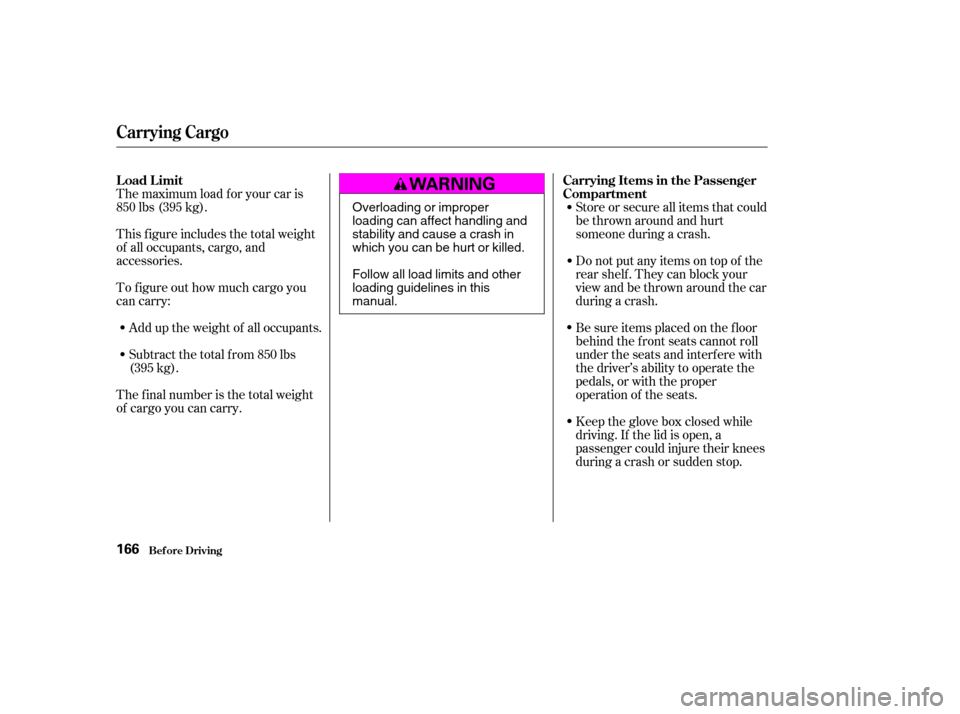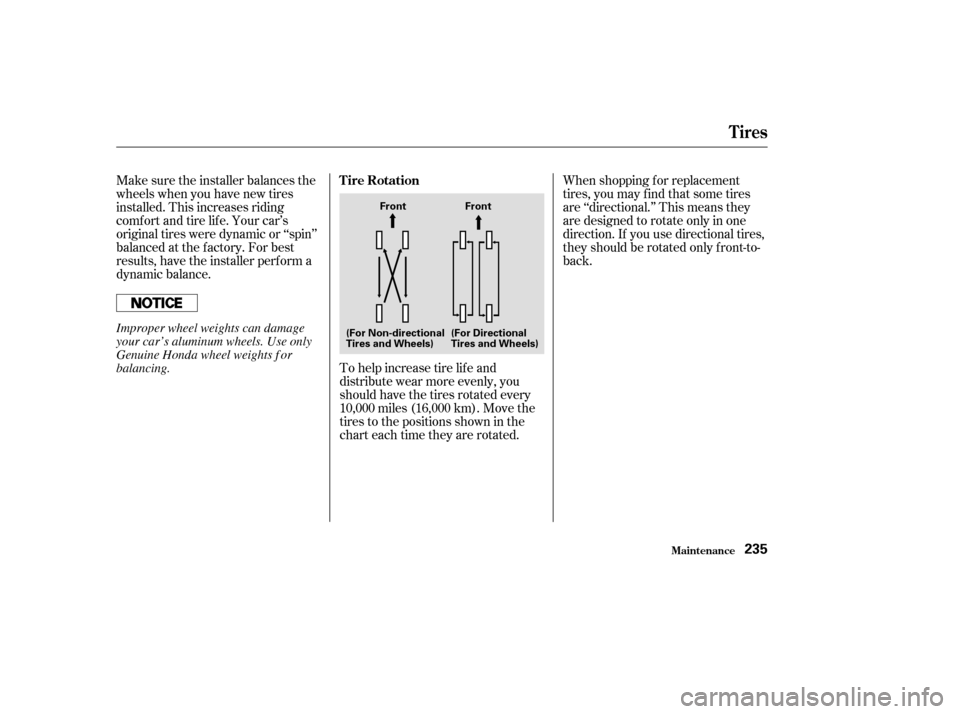Page 160 of 302
�Î�Î
�Î �Î
Your car has several convenient
storage areas so you can stow cargo
saf ely.
However, carrying too much cargo,
or improperly storing it, can af f ect
your car’s handling, stability, and
operation, and make it unsaf e.
Bef ore carrying any type of cargo, be
sure to read the f ollowing pages.
The glove box, and the pockets in
the front doors and seat-back, are
designed f or small, lightweight items.
The trunk is intended f or larger,
heavier items. In addition, the back
seatcanbefoldeddowntoallowyou
to carry more cargo or longer items.
Carrying Cargo
Bef ore Driving165
TRUNK
CONSOLE COMPARTMENT FRONT DOOR POCKET
GLOVE BOX
SEAT-BACK POCKET 1: U.S.: LX and EX models
Canada: LX and Si models
2: U.S.: HX, LX and EX models Canada: LX and Si models
1
2
�����—�����—�����y�
���������
���y���
�(���%�������y���
�����y
Page 161 of 302

Store or secure all items that could
be thrown around and hurt
someone during a crash.
Be sure items placed on the f loor
behind the f ront seats cannot roll
under the seats and interf ere with
the driver’s ability to operate the
pedals, or with the proper
operation of the seats.
Keep the glove box closed while
driving. If the lid is open, a
passenger could injure their knees
during a crash or sudden stop.
This f igure includes the total weight
of all occupants, cargo, and
accessories.
To f igure out how much cargo you
can carry:
Add up the weight of all occupants.
The f inal number is the total weight
of cargo you can carry.
The maximum load for your car is
850 lbs (395 kg).
Subtract the total f rom 850 lbs
(395 kg). Do not put any items on top of the
rear shelf . They can block your
view and be thrown around the car
during a crash.
Carrying Items in the Passenger
Compartment
Load Limit
Carrying Cargo
Bef ore Driving166
Overloading or improper
loading can affect handling and
stability and cause a crash in
which you can be hurt or killed.
Follow all load limits and other
loading guidelines in thismanual.
�����—�����—�����y�
�������������y���
�(���%�������y���
�����y
Page 162 of 302
Distribute cargo evenly on the
f loor of the trunk, placing the
heaviest items on the bottom and
as far forward as possible.
If youfolddownthebackseat,tie
down items that could be thrown
about the car during a crash or
sudden stop.If you can carry any items on a
roof rack, be sure the total weight
of the rack and the items does not
exceed the maximum allowable
weight. Please contact your Honda
dealer f or f urther inf ormation.
If you carry large items that
prevent you f rom closing the trunk
lid, exhaust gas can enter the
passenger area. To avoid the
possibility of carbon monoxide
poisoning, f ollow the instructions
on page .
55
Carrying Cargo in the Trunk or on
a Roof Rack
Carrying Cargo
Bef ore Driving167
�����—�����—�����y�
�������������y���
�(���%�������y���
�����y
Page 197 of 302
The SAE number tells you the oil’s
viscosity or weight. Select the oil f or
your vehicle according to this chart.You may use a synthetic motor oil if
it meets the same requirements
given f or a conventional motor oil: it
displays the API Certif ication Seal,
and it is the proper weight as shown
on the chart. When using synthetic
oil, you must f ollow the oil and f ilter
change intervals given in the
maintenance schedule.
Your Honda does not require any oil
additives. Additives may adversely
af f ect your engine’s or transmission’s
perf ormance and durability.
5W-20 oil is f ormulated f or year-
round protection of your Honda, to
improve cold weather starting, and
to help your engine use less f uel.
Engine Oil
Maint enance
Synthetic Oil
A dditives
204
Ambient Temperature
�����—�����—�����y�
�������������y���
�(���%�������y���������y
Page 228 of 302

When shopping f or replacement
tires, you may find that some tires
are ‘‘directional.’’ This means they
are designed to rotate only in one
direction. If you use directional tires,
they should be rotated only front-to-
back.
Make sure the installer balances the
wheels when you have new tires
installed. This increases riding
comf ort and tire lif e. Your car’s
original tires were dynamic or ‘‘spin’’
balanced at the f actory. For best
results, have the installer perf orm a
dynamic balance.
To help increase tire lif e and
distribute wear more evenly, you
should have the tires rotated every
10,000 miles (16,000 km). Move the
tires to the positions shown in the
chart each time they are rotated.
Tire Rotation
Tires
Maint enance235
Front Front
(For Non-directional
Tires and Wheels) (For Directional
Tires and Wheels)
Improper wheel weights can damage
your car’s aluminum wheels. Use only
Genuine Honda wheel weights f or
balancing.
�����—�����—�����y�
�������������y���
�(���%�������y���������y
Page 275 of 302

If you decide to tow your car with all
f our wheels on the ground, make
sure you use a properly-designed and
attached tow bar. Prepare the car for
towing as described above, and leave
the ignition switch in Accessory (I)
so the steering wheel does not lock.
Make sure the radio and any items
plugged into the accessory power
socket are turned of f so they do not
rundownthebattery.
With the f ront wheels on the ground,
it is best to tow the car no farther
than 50 miles (80 km), and keep the
speedbelow35mph(55km/h).
If your car is equipped with a f ront
spoiler, remove it bef ore towing so it
is not damaged.
Emergency T owing
T aking Care of t he Unexpect ed284
Trying to lif t or tow your car by the
bumpers will cause serious damage.
The bumpers are not designed to
support the car’s weight.
The steering system can be damaged if
the steering wheel is locked. Leave the
ignition switch in Accessory (I), and
make sure the steering wheel turns
f reely bef ore you begin towing.
�����—�����—�����y�
�������������y���
�(���%�������y���������y
Page 278 of 302

�Î�Î�Î �Î �Î�Î�Î�Î
�Î �Î
�Î �Î
�Î �Î �Î�Î
�Î
�Î�Î
Specif ications
T echnical Inf ormation288
Dimensions
Weights
Engine Capacities
174.7 in (4,438 mm)
66.7 in (1,695 mm)
55.1 in (1,399 mm)
103.1 in (2,620 mm)
57.9 in (1,470 mm)
57.9 in (1,470 mm)
2.95 x 3.72 in (75.0 x 94.4 mm) 13.2 US gal (50
)
102 cu-in (1,668 cm
)
9.5 9.9
Length
Width
Height
Wheelbase
Track
Gross vehicle weight rating See the certification label attached
to the driver’s doorjamb.
Type
BorexStroke
Displacement
Compression ratio
Spark plugs Water cooled 4-stroke
SOHC , SOHC VTEC
4-cylinder gasoline engine
Excluding the oil remaining in the engine.
Including the coolant in the reserve tank and that remaining in the
engine.
Reserve tank capacity: 0.108 US gal (0.41
)
4.8 US qt (4.5
)
2.6 US qt (2.5)
6.0 US qt (5.7)
6.3 US qt (6.0)
3.4 US qt (3.2)
2.9 US qt (2.7)
1.7 US qt (1.6)
1.6 US qt (1.5)
4.4 US qt (4.2)
3.5 US qt (3.3)
3.2 US qt (3.0)
3.7 US qt (3.5)
3.4 US qt (3.2)
Fuel tank
Engine
coolant
Engine oil Automatic
transmission
fluid 1.03 US gal (3.9
)
1.00 US gal (3.8)
1.00 US gal (3.8)
1.32 US gal (5.0
)
1.29 US gal (4.9)
1.29 US gal (4.9)
See spark plug maintenance
section page 221 .
FrontRear
Approx.
U.S.: HX, EX
Canada: Si HX
DX, LX
EX, HX
3: 4: 5:6:
7:
DX, LX
1:2: Change
ManualAutomaticCVT
Total ManualAutomaticCVT
Change Including
filter
Without filter
Total
ChangeTotal
Change Total
U.S. Cars
Canada Cars
12
12 5656
7 7
3 4
Manual trans-
mission fluid
Windshield
washer reservoir
�����—�����—�
���y�
���������
���y���
�(���%�������y�������
�y